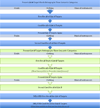An evaluation of deficits in semantic cueing and proactive and retroactive interference as early features of Alzheimer's disease
- PMID: 23768680
- PMCID: PMC4668200
- DOI: 10.1016/j.jagp.2013.01.066
An evaluation of deficits in semantic cueing and proactive and retroactive interference as early features of Alzheimer's disease
Abstract
Objectives: To determine the degree to which susceptibility to different types of semantic interference may reflect the initial manifestations of early Alzheimer's disease (AD) beyond the effects of global memory impairment.
Methods: Normal elderly (NE) subjects (n = 47), subjects with amnestic mild cognitive impairment (aMCI; n = 34), and subjects with probable AD (n = 40) were evaluated by using a unique cued recall paradigm that allowed for evaluation of both proactive and retroactive interference effects while controlling for global memory impairment (i.e., Loewenstein-Acevedo Scales of Semantic Interference and Learning [LASSI-L] procedure).
Results: Controlling for overall memory impairment, aMCI subjects had much greater proactive and retroactive interference effects than NE subjects. LASSI-L indices of learning by using cued recall revealed high levels of sensitivity and specificity, with an overall correct classification rate of 90%. These measures provided better discrimination than traditional neuropsychological measures of memory function.
Conclusions: The LASSI-L paradigm is unique and unlike other assessments of memory in that items posed for cued recall are explicitly presented, and semantic interference and cueing effects can be assessed while controlling for initial level of memory impairment. This is a powerful procedure that allows the participant to serve as his or her own control. The high levels of discrimination between subjects with aMCI and normal cognition that exceeded traditional neuropsychological measures makes the LASSI-L worthy of further research in the detection of early AD.
Keywords: Early Alzheimer's; MCI; early detection; memory; proactive interference; semantic cueing; semantic interference.
Copyright © 2014 American Association for Geriatric Psychiatry. Published by Elsevier Inc. All rights reserved.
References
-
- Cummings JL, Doody L, Clark C. Disease modifying therapies for Alzheimer’s disease: Challenges to early intervention. Neurology. 2007;69:1622–1634. - PubMed
-
- Dubois B, Feldman HH, Jacova C, et al. Research criteria for the diagnosis of Alzheimer's disease: revising the NINCDS-ADRDA criteria. Lancet Neurol. 2007;6:734–746. - PubMed
-
- Almkvist O. Neuropsychological features of early Alzheimer's disease: Preclinical and clinical stages. Acta Neurol Scand. 1996;93:63–71. - PubMed
Publication types
MeSH terms
Grants and funding
LinkOut - more resources
Full Text Sources
Other Literature Sources
Medical


